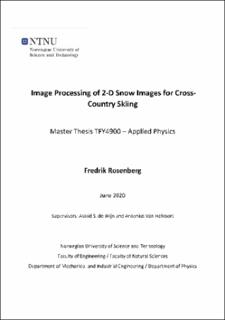| dc.contributor.advisor | de Wijn, Astrid S. | |
| dc.contributor.advisor | Van Helvoort, Antonius | |
| dc.contributor.author | Rosenberg, Fredrik | |
| dc.date.accessioned | 2021-09-28T18:36:26Z | |
| dc.date.available | 2021-09-28T18:36:26Z | |
| dc.date.issued | 2020 | |
| dc.identifier | no.ntnu:inspera:57076746:33127854 | |
| dc.identifier.uri | https://hdl.handle.net/11250/2785533 | |
| dc.description.abstract | Snø er et porøst og komplekst materiale med innflytelse på både vitenskapelige, teknologiske og sosiale arenaer. Dette gjør analyse av snø til en viktig, men krevende oppgave. Tredimensjonal snø analyse gir nøyaktig karakterisering av snøens mikrostruktur, men disse metodene er ofte tidkrevende i tillegg til å avhenge av mindre tilgjengelig utstyr. For å få et bedre bilde av hvordan snøens struktur endrer seg i rom og tid, er det derfor behov for mindre omfattende metoder for karakterisering av snø. For langrennsski vil snøens struktur ha direkte innflytelse på friksjonen og dermed ytelsen til skiene. Analyse av de gjeldende og lokalt varierende snøforholdene vil dermed gi verdifull informasjon om hvordan skiene bør prepareres for å oppnå bedre resultater. I denne rapporten er de presenterte metodene basert på analyse av todimensjonale bilder av snø. Bildene er tatt med et instrument ved navn GelSight, et håndholdt og bærbart instrument som raskt og effektivt fanger bilder av snøens overflate. Den første metoden innebærer å bruke digitale konturer for å approksimere areal og omkrets av snøkornene. Fra dette kan man bestemme den Optisk Ekvivalente Diameteren (OED) og 'dendricity', to parametere som karakteriserer størrelsen og formen på snøkornene. Den andre metoden bruker maskinlæringsalgoritmene 'Support Vector Machine' (SVM) og 'Convolutional Neural Network' (CNN) for å klassifisere snø som ny eller gammel. Kontur-metoden lykkes i å skille forskjellige snøforhold gjennom OED og 'dendricity' verdiene, og SVM og CNN algoritmene oppnår en treffsikkerhet på henholdsvis 95.8% og 97.9% på klassifiseringen. De strukturelle parameterne og klassifiseringen relaterer direkte til friksjon, og den presenterte snø analysen gir derfor verdifull informasjon om snøforholdene relevant for ytelsen til langrennsski. | |
| dc.description.abstract | Snow is a porous and complex material influencing a great variety of scientific, technological and societal fields, making snow analysis an important but demanding task. Although three-dimensional snow analysis techniques provide comprehensive and accurate characterization of the snow's microstructure, these methods are often time consuming and require less accessible equipment. To obtain a better impression of the temporal and spatial variations in the snow's structure, more facile probing methods are needed. For cross-country skiing, the snow's structure has direct impact on friction and thus the final performance of the skis. Hence, analysing the current and locally varying snow conditions will give valuable information on how to best prepare the skis in order to achieve better overall results. The presented methods in this study are based on image analysis of two-dimensional images. These are acquired on an instrument called GelSight, which is a handheld and portable imaging system enabling fast and effective imaging of the snow's surface. The first image processing method involves the use of digitized contours to approximate the area and perimeter of snow grains. This allows determining the Optical Equivalent Diameter (OED) and dendricity, two metrics characterizing the size and shape of the grains. A second processing method involves using the machine learning algorithms Support Vector Machine (SVM) and Convolutional Neural Network (CNN) to classify snow images into categories as old and new snow. The contouring method is shown to successfully separate different snow conditions through the calculated OED and dendricity, and the SVM and CNN algorithms achieve an accuracy on the classification of 95.8% and 97.9%, respectively. As the structural parameters and classification relate directly to the observed property of friction, the presented snow analysis is indeed providing valuable information regarding snow conditions relevant to the performance of cross-country skis. | |
| dc.language | | |
| dc.publisher | NTNU | |
| dc.title | Image Processing of 2-D Snow Images for Cross-Country Skiing | |
| dc.type | Master thesis | |
